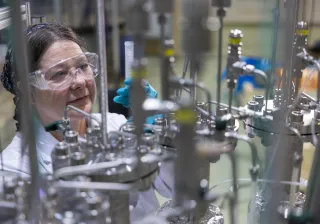The environmental state of affairs is severe. Substantial changes are inevitable in the light of the prevailing untenable consumption trends of natural resources. Replacing the linear economy with a circular one, in which materials stay in use for extended time periods, offers a possible solution to this dilemma. The shift of paradigm, however, comes with a price tag and the new normal has its own challenges. One of the central problems has to do with the fact that we are lacking means of collaborative design enabling us to determine the impacts of the change overall, as well as the impacts on the individual players in the process. For this reason, VTT has started to develop a digital design platform, which helps its users to understand the pros and cons of different circular design options. Companies can utilize it, for example, to discover the bottlenecks and optimal material choices as part of their own design processes. The digital tools offered via the platform equip the users with powerful integrated design features encompassing life cycle assessment and life cycle cost, system dynamics and ICME based materials modelling capabilities, among others.
While current design methods and tools make it possible, in principle, to combine various points of view, the underlying problem of design, in general, is that the linkages between various decision-making domains are broken or non-optimally arranged. By decision-making, we refer to any type of company activity associated with planning changes in their current practices, such as scaling up existing production or estimating impacts of using different raw materials or packaging methods in production processes on the final product performance, costs, or environmental impacts.
In addition to the imperfect inclusion of cross-domain information, the current design paradigm suffers from a certain type of ‘jet lag’. In other words, different design inputs are in many cases obtained and required too late in the design process (cf. the adaptation of the oversimplified 80:20 rule in this case: majority of the total costs are locked in within the short initial design period).
We aim to challenge this old way of design by offering a more holistic viewpoint. The transition to a circular thinking can happen more swiftly, if different players (companies) of the forthcoming circular economy get a bird’s eye view of the possible impacts of the design scenarios affecting all companies within the value chain or network of their product in addition to their own. This creates stronger incentives to change the existing paradigms related to design of products and business models as with bird’s eye view the possibility of discovering value-chain level ‘loopholes’ and winning combinations increases significantly.
As we are still in the early phases, many design parameters, which earn to be uplifted to the status of internationally recognized performance measures or key impact indicators (KPIs), are still missing. Their development and incorporation into the circular design streams remains as one of our main tasks: with the aid of sensible ‘yardsticks’, we are able to decide when it is useful to try to create closed materials circulation loops and when we should try something different. We will also be able to tell, when partial optimization, which is a natural company and human specific behavioral model, is more useful or harmful from the point of view of the performance level of the entire value chain.
Giving concrete meaning to circular design with VTT’s tools
We are currently developing a simulation assisted design platform, which enables more quantitative construction, comparison and optimization of different circular economy design choices. Moreover, non-conventional, potentially bigger wins offering collaborative design features will also be supported by the new platform. VTT’s wide domain knowledge can be brought together by integrating simulation models from various fields comprising, inter alia, system dynamic modeling, life cycle assessment (LCA) and cost (LCC) simulators, business models and materials performance models (ProperTune ICME) and offering customers access to all these interlinked domains in one go. In essence, circular economy design creates pressure for different companies to start thinking about benefits of collaborative design. It also creates pressure for different institutions, such as VTT, to create more integrated design service portfolios, to support which our platform is among the first ones.
In nutshell, our new quantitative analysis tools will complement the offering of existing CE design tools having more qualitative nature. The quantitative nature of our design toolset is further backed up by the inclusion of existing international standards (e.g. ISO14067, 14069 for LCA) as the backbone that makes the computable KPIs comparable worldwide. The same standardization adoption philosophy applies to other fields, as well. In addition, VTT’s researchers both follow and actively participate in the development of new standards and their associated KPIs and measurement methods.
Combining different fields of design
One of the new features offered by our circular economy design toolset is the possibility to perform Life Cycle Cost computations in a more deeply integrated fashion. As a new type of procedural innovation, we have experimented with the possibility of utilizing companies’ existing and planned business models as part of the conventional product and process design from an early point on. While the strategy and business model development is, perhaps, traditionally seen as a somewhat separate process from the ‘more concrete’ product design, we feel that successful circular design forces them to come closer together. In short, it is possible to derive various constraints and parametrizable KPIs from the company’s business model, which can be brought to affect directly the available design parameter space of the product and process planners. Conversely, KPIs originating from the latter perspective, can be used to produce what-if-scenarios, which are beneficial for the business model development .
Holistic circular economy design practices draw input in addition to the economic and ecologic KPIs from materials design , which is part of the traditional product design. Combining the latter with life cycle cost evaluations, we can offer companies direct ways to assess the impacts of different materials use possibilities. It is even possible to try to predict the notoriously difficult consumer responses or other time-dependent effects using system dynamic modeling. Of course, the longer the estimation period, the larger the insecurities in all predictions, not just the in the difficult to predict human behavior, but also the in the ‘straightforward’ physics’ and chemistry laws based materials behavior estimates. The point is, the best possible contemporary knowledge packaged into simulation models can be brought about to produce an integrated view into the possible scenarios with estimation of insecurity included in a quantifiable manner.
In the end, it is important to remember that for decision-making, it typically suffices to give an order of estimate, or determine the direction of the development of events, such as the direction of some design indicator (is it going to grow or diminish). Furthermore, the important thing is to utilize existing standards (in evaluation and modeling) to make results comparable. Absolute truths/values in estimates are not realistic to obtain, but relative differences can surprisingly often be computed.
Integration platform ensures easy usability
It makes a lot of sense not only from the point of view of the companies but also from the point of view of the research institutions such as VTT, to aim for the capability to offer more comprehensive design domain integration. Developing an interdisciplinary offering within VTT boosts the degree of academic excellence of the several substance areas. The prototype environment acting as one possible realization for the design platform development enabling the collaboration of different research groups in and outside of VTT, is called Modelling Factory. This platform is open to all modelers, who wish to bring their software into the use of larger group of developers interested in implementing integrated design features for collaborative circular design. Self-evidently, development of platform economy is part of development of circular economy and the overarching principle of collaboration.






